Assessment, Accreditation and Strategic Planning
National Survey of Student Engagement - 2005 Campus Results
The National Survey of Student Engagement (NSSE)
evaluates the effectiveness of productive student engagement each year
by surveying college freshmen and seniors. The NSSE results a summarized
across five nationally recognized effective educational practice
benchmarks: Level of Academic Challenge, Active & Collaborative
Learning, Student-Faculty Interaction, Enriching Educational
Experiences, and Supportive Campus Environment. In Spring 2005, approximately 245,000 students from among 527 colleges and universities
participated in NSSE.
Data for Western’s 2005 NSSE results are based on the
participation of the 25% of our freshmen and 35% of our seniors who
elected to participate in the online national survey.
National Benchmark Comparisons - Longitudinal Analysis vs. 2004 Campus Pilot
Western Illinois University’s comparative levels of achievement for each of these NSSE benchmarks are determined by assigning a value of 100 to the normative score attained by all participating institutions with our same Carnegie classification. WIU values exceeding the national Carnegie class average are above 100% and those WIU values not reaching the national average are below 100%.
Western’s comparative score is presented graphically below for each of the 5 effective educational practice benchmarks. Additional reports provide a tabular comparison for each of the considered elements of the five effective educational practice benchmarks, as well as present results by campus and college.
Summary
The Spring 2004 results provided a pilot measure for comparison and the Spring 2005 results will be used to help measure the success of the new FYE program.
The 2005 results demonstrated a marked effect regarding our efforts to provide a more positive learning experience for seniors, but the largest ever freshmen class hindered efforts on that front. The new First Year Experience (FYE) program for all of our incoming freshmen which began Fall 2005 will hopefully address many these limitations, while we still strive to improve on the educational experience provided to the rest of our student body.
Level of Academic Challenge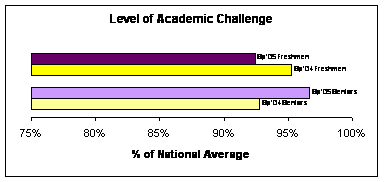
Western’s seniors in 2004 had less academic challenge than WIU freshmen, and less than at other similar institutions. Faculty addressed this concern and results showed marked improvement in 2005. However, the academic challenge for freshmen declined, an issue which should be addressed by the new FYE program and it’s emphasis on discussion, integration, and adapting to college.
Active and Collaborative Learning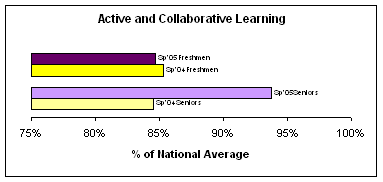
Both WIU freshmen and seniors had below desired levels of active and collaborative learning in 2004. Faculty were challenged to address this concern, and were successful, with seniors showing considerable improvement in 2005. However, freshmen marginally lost pace. Again, the new FYE program should be of benefit as it, encourages active and collaborative learning.
Student-Faculty Interaction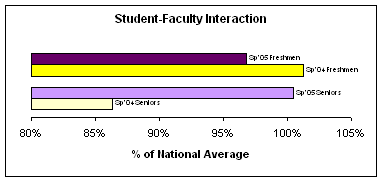
In 2004, WIU freshmen had greater student-faculty interaction than similar institutions, but our seniors were not receiving the same benefit. Faculty rose to the challenge, with seniors surpassing the national 2005 average. Freshmen, ahead of the national mark in 2004, fell below the standard in 2005. The emphasis on student-faculty interaction in the new FYE program should resolve this concern in 2006.
Enriching Educational Experience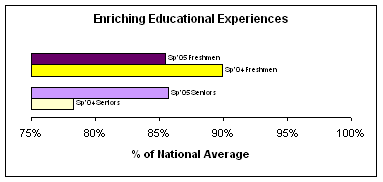
Out-of-classroom learning activities are vital to the educational experience. While WIU freshmen in 2004 were below the national average, the greatest concern was for seniors. Broad-based effort across campus helped address this issue with seniors moving up the scale in 2005. The addition of co-curricular activities as part of the FYE program should show improvement, both for freshmen and seniors.
Supportive Campus Environment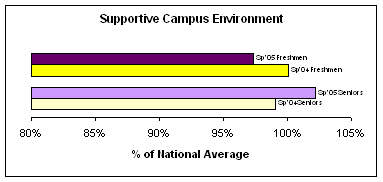
Freshmen and seniors report WIU as providing a very supportive environment. In 2004, seniors were slightly below the national average, but well above in 2005. Freshmen, however, declined in their perceptions for 2005, an area which is currently under investigation across campus. The supportive nature of Western’s new FYE program is expected to benefit new students in this area.
In-Depth Analysis
A more in-depth analysis providing the individual components that comprise each of the 5 NSSE benchmarks of effective educational practices is provided below in PDF format.
- 2005 NSSE Level of Academic Challenge
- 2005 NSSE Active and Collaborative Learning
- 2005 NSSE Faculty-Student Interaction
- 2005 NSSE Enriching Educational Environment
- 2005 NSSE Supportive Campus Environment

Connect with us: